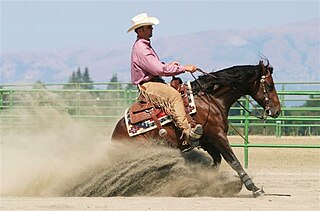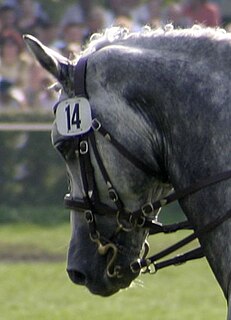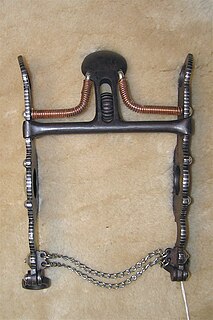
The mecate ( /məˈkɑːtiː/ or less anglicized /məˈkɑːteɪ/ ; Spanish pronunciation: [meˈkate] ) is the rein system of the bosal style hackamore used to train young horses. It is a long rope, traditionally of horsehair, approximately 20–25 feet long and up to about 3/4 inch in diameter. It is tied to the bosal in a specialized manner that adjusts the fit of the bosal around the muzzle of the horse, and creates both a looped rein and a long free end that can be used for a number of purposes. [1] When a rider is mounted, the free end is coiled and attached to the saddle. When the rider dismounts, the lead rein is not used to tie the horse to a solid object, but rather is used as a lead rope and a form of Longe line when needed. [2]

Reins are items of horse tack, used to direct a horse or other animal used for riding. They are long straps that can be made of leather, nylon, metal, or other materials, and attach to a bridle via either its bit or its noseband.

A bosal is a type of noseband used on the classic hackamore of the vaquero tradition. It is usually made of braided rawhide and is fitted to the horse in a manner that allows it to rest quietly until the rider uses the reins to give a signal. It acts upon the horse's nose and jaw. Though seen in both the "Texas" and the "California" cowboy traditions, it is most closely associated with the "California" style of western riding. Sometimes the term bosal is used to describe the entire classic hackamore or jaquima. Technically, however, the term refers only to the noseband portion of the equipment.

A hackamore is a type of animal headgear which does not have a bit. Instead, it has a special type of noseband that works on pressure points on the face, nose, and chin. It is most commonly associated with certain styles of riding horses.
The traditional mecate was an integral part of the vaquero culture that became the California tradition of western riding. The classic mecate is hand-braided of horsehair, usually long hair from the tail, often a blend of black and white hairs made into an alternating design. Modern mecates are made not only of horsehair, but also of synthetic rope, usually of a solid dark color, sometimes with a horsehair tassel at one end and a leather popper or quirt at the other.

The vaquero is a horse-mounted livestock herder of a tradition that originated on the Iberian Peninsula. Today the vaquero is still a part of the doma vaquera, the Spanish tradition of working riding. The vaquero traditions developed in Mexico from methodology brought to Mesoamerica from Spain and became the foundation for the North American cowboy. The vaqueros of the Americas were the horsemen and cattle herders of Spanish Mexico, who first came to California with the Jesuit priest Eusebio Kino in 1687, and later with expeditions in 1769 and the Juan Bautista de Anza expedition in 1774. They were the first cowboys in the region.

Western riding is a style of horse riding which evolved from the ranching and warfare traditions brought to the Americas by the Spanish Conquistadors, and both equipment and riding style evolved to meet the working needs of the cowboy in the American West. American cowboys needed to work long hours in the saddle over rough terrain, sometimes needing to rope cattle with a lariat. Because of the necessity to control the horse with one hand and use a lariat with the other, western horses were trained to neck rein, that is, to change direction with light pressure of a rein against the horse's neck. Horses were also trained to exercise a certain degree of independence in using their natural instincts to follow the movements of a cow, thus a riding style developed that emphasized a deep, secure seat, and training methods encouraged a horse to be responsive on very light rein contact.

A quirt is a forked type of whip which usually has two falls at the end, sometimes called a riding quirt or horse quirt.


A mecate knot begins at the heel knot of the bosal, where the mecate is anchored with a wrap of rope similar to the clove hitch. Next, the looped rein is formed coming off the top of the bosal. Then, the loose end is wrapped two or more times in front of the rein loop until the bosal is the proper diameter to fit the horse, and secured with another clove hitch, leaving the long lead rein end coming out the bottom of the bosal, secured by the last wrap. A properly tied mecate knot allows wraps of rope to be added to the knot in front of the rein loop in order to tighten the bosal noseband on a horse, or the rope can be unwrapped to loosen the bosal. Sometimes, a heavy bosal is stabilized by the addition of a fiador, which is a type of throatlatch usually made of thin cotton rope. The fiador attaches in front of the mecate so as to not interfere with the action of the reins. The mecate may need to be loosened to accommodate the fiador if used.
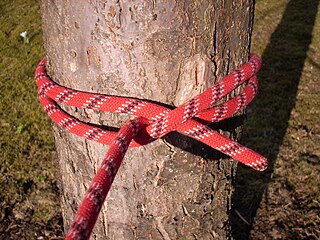
The clove hitch is a type of knot. Along with the bowline and the sheet bend, it is often considered one of the most important knots and is commonly referred to as a Double Hitch. A clove hitch is two successive half-hitches around an object. It is most effectively used as a crossing knot. It can be used as a binding knot, but is not particularly secure in that role. A clove hitch made around the rope's own standing part is known as either two half-hitches or buntline hitch, depending on whether the turns of the clove hitch progress away from or towards the hitched object.
Although the name clove hitch is given by Falconer in his Dictionary of 1769, the knot is much older, having been tied in ratlines at least as early as the first quarter of the sixteenth century. This is shown in early sculpture and paintings. A round turn is taken with the ratline and then a hitch is added below. The forward end is always the first to be made fast.
The difference between two half hitches and the clove hitch is that the former, after a single turn around a spar, is made fast around its own standing part, while the latter is tied directly around the spar.
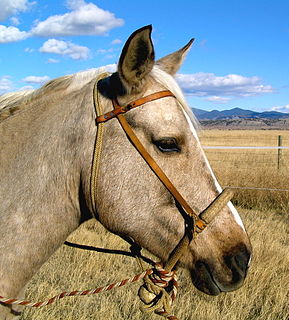
A fiador term of Spanish colonial origin referring to a hackamore component used principally in the Americas. In English-speaking North America, the fiador is known principally as a type of throatlatch used on the bosal-style hackamore. Its purpose is to stabilize a heavy noseband or bosal and prevent the bridle from shifting. It is not used for tying the horse.
A variation, sometimes called "mecate reins" and other times a "McCarty" or "McCarthy outfit," is used as a rein system for a bridle with a bit. This design, usually of cotton rope or web, consists of a single looped rein attached to either site of a snaffle bit with a lead rein coming off of the left bit ring in a manner similar to the lead rein of the traditional mecate. This setup is most often seen today among some practitioners of the natural horsemanship movement. Sometimes considered an adaptation of the California tradition to the Texas tradition, it allows the rider to hold on to the horse while on the ground, but the drawback to the design is that the lead rein comes off of one side of the bit, creating an imbalance in the horse's mouth. To balance the lead rein, some users add a large tassle on the bight off the other side of the bit. The lead rein also cannot be used for longing the horse in both directions, as it is attached only on the left.

A bridle is a piece of equipment used to direct a horse. As defined in the Oxford English Dictionary, the "bridle" includes both the headstall that holds a bit that goes in the mouth of a horse, and the reins that are attached to the bit.

A bit is a type of horse tack used in equestrian activities, usually made of metal, or a synthetic material. It is placed in the mouth of a horse and assists a rider in communicating with the animal. It extends from one side of the mouth across to the other and rests on the bars of the mouth, which are a region, between the incisors and the molars, where there are no teeth. It is held on a horse's head by means of a bridle and has reins attached for use by a rider.

A snaffle bit is the most common type of bit used while riding horses. It consists of a bit mouthpiece with a ring on either side and acts with direct pressure. A bridle utilizing only a snaffle bit is often called a "snaffle bridle", particularly in the English riding disciplines. A bridle that carries two bits, a curb bit and a snaffle, or "bradoon", is called a double bridle.
